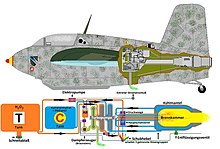Walter HWK 109-509

The Walter HWK 109-509 is a liquid rocket propulsion system that was developed by the Hellmuth Walter engineering office in Kiel (HWK) during World War II . All top secret jet engines and rocket drives were assigned the inconspicuous prefix “109” in the type number by the Reich Aviation Ministry (RLM) . (see also: Junkers Jumo 004 ) The HWK-109-509 rocket drive was used in the Messerschmitt Me 163 and the Bachem Ba 349 , among others .
technology
The basis was the test engine Walter R 1-203 , which worked on the principle of the “cold” Walter engine , in which highly reactive substances T-substance and Z-substance (a solution of hydrogen peroxide and potassium permanganate ) decompose in a reaction chamber. Temperatures of 700 to 800 ° C arise and the nozzle is essentially high-tension water vapor and oxygen.
In order to be able to make better use of the free oxygen content, the “hot” process was developed by adding a hydrocarbon to the catalytic converter component of the fuel . Methyl alcohol proved to be suitable here.
So came instead of the Z-material of the so-called C-Fabric (a mixture of 30% hydrazine hydrate + 57% methanol + 13% water with residual amounts of potassium copper cyanide) and as oxidizer again T-cloth (80% hydrogen peroxide and 20 % 8-hydroxyquinoline ) is used. The exhaust gas temperature doubled compared to the "cold" process. The A-1 version has a length of 2.53 meters, the mass 175 kilograms and the thrust 5 to 15 kN .
The engine was designed as an integral construction; all components of the drive with the exception of the fuel tanks were fixed in a frame. The decomposition of T-substance in a decomposition pot filled with porous manganese dioxide resulted in a hot steam-oxygen mixture that drove the multi-flow turbo pump for pumping T- and C-substance. The fuel was first fed at high pressure into the double jacket of the combustion chamber in order to cool it. It then flowed back to a control unit in the main frame of the engine, in which the quantity of the two components was precisely matched. From here it flowed back to the combustion chamber, into which it was injected through atomizer nozzles.
One advantage of the HWK 109-509 was its adjustability. The engine could be operated with a thrust from 100 to 1600 kp that was adjustable in five stages (off, idle, 1, 2, 3). It could be switched off at the altitude, after which the planes attacked and landed while gliding . A restart after a cooling time of approx. 2 minutes was possible in order to use the remaining fuel. Due to the high explosiveness of the fuel, however, there were a number of accidents, some of them fatal. In 1941 Heini Dittmar was the first person to reach a speed of over 1000 km / h in a Messerschmitt Me 163 .
Types
- A-0 : Pre-series version, was manufactured from May 1943. The thrust of this engine could be regulated between 300 kp (2.9 kN) and 1500 kp (14.7 kN).
- A-1 : First series version, was built into the Me 163 B from August 1944. The thrust could be regulated from 100 kp (1 kN) to 1600 kp (15.7 kN).
- A-2 : Version for the Me 163 C. In addition to the main combustion chamber, this engine also had a so-called marching combustion chamber (also known as a marching furnace), which delivered an additional thrust of 300 kp (2.9 kN). If the main combustion chamber was switched off, the rocket engine could be operated with the marching combustion chamber alone; thus the running time and thus the flight time could be increased. The thrust of the main combustion chamber could be regulated from 200 kp (2 kN) to a maximum of 1700 kp (16.7 kN).
- B-1 : Performance-enhanced version of the A-1. Thrust adjustable between 100 kp (1 kN) and 2000 kp (19.6 kN). Used in the Me 163 B-1.
- C-1 : Based on the A-2 performance-enhanced version. Thrust of the main jet between 400 kp (3.9 kN) and 2000 kp (19.6 kN), the travel jet 400 kp (3.9 kN)
- D-1 : Variant of the C-1 for use in the Bachem Ba 349 B. Designed for parachute drop .
Web links
Individual evidence
- ^ Botho Stüwe: Peenemünde-West .
- ↑ The Luftwaffe's test site for secret radio-controlled weapons and their development history. Bechtermünz-Verlag, Augsburg 1998, ISBN 3-8289-0294-4 , p. 220.
- ↑ a b display board in the DTMB
- ^ Botho Stüwe: Peenemünde-West. The Luftwaffe's test site for secret radio controlled weapons and their development history. Bechtermünz-Verlag, Augsburg 1998, ISBN 3-8289-0294-4 , p. 221f.


